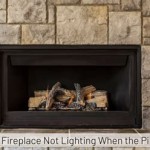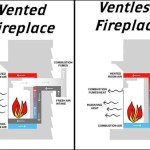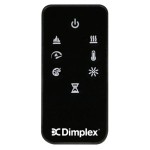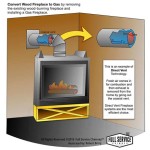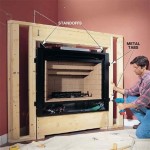How Much Does It Cost To Install A Wood Burning Fireplace Insert?
Installing a wood-burning fireplace insert can be a significant home improvement project, offering supplemental heat and a cozy ambiance. However, understanding the associated costs is crucial for budgeting and planning. The total expense can vary considerably based on factors such as the insert's type, size, installation complexity, and regional labor rates. This article will explore the different cost components to provide a comprehensive overview of what to expect financially when installing a wood-burning fireplace insert.
A wood-burning fireplace insert is a self-contained heating appliance designed to fit into an existing masonry fireplace. Unlike a traditional fireplace, which is known for its inefficiency (often losing more heat up the chimney than it provides), an insert is designed to maximize heat output. An insert typically features a cast iron or steel firebox, surrounded by a decorative surround that seals off the fireplace opening. This design forces the heat to radiate into the room rather than escaping up the chimney. Furthermore, most inserts include a blower that circulates the heated air for more efficient distribution.
Before delving into the cost breakdown, it is essential to distinguish between different types of fireplace inserts. Wood-burning inserts are the most common, offering a tangible connection to traditional heating methods. Gas fireplace inserts, powered by natural gas or propane, provide convenience and ease of use. Electric fireplace inserts offer a purely aesthetic appeal, simulating the look of a fire without producing actual heat (though some models do offer heating capabilities). Because our focus is on wood-burning inserts, all pricing discussed will relate solely to this type.
Cost of the Wood Burning Fireplace Insert Unit
The insert itself constitutes a significant portion of the overall cost. Prices for wood-burning fireplace inserts generally range from $1,500 to $4,000 and up, depending on several factors. Size and heating capacity are primary drivers of cost. A larger unit designed to heat a larger space will naturally cost more than a smaller one intended for supplemental heating in a smaller room.
Material quality also plays a role. Cast iron inserts are generally more expensive than steel inserts, due to the enhanced heat retention properties of cast iron. However, modern steel inserts often incorporate ceramic or firebrick lining to improve their efficiency and durability, potentially increasing their price. The design and aesthetics of the insert also influence the cost. A simple, utilitarian model will be less expensive than a decorative insert with intricate detailing or special finishes. The brand of the insert also impacts pricing. Established brands with a reputation for quality and performance often command a premium.
Features such as catalytic combustors or non-catalytic combustion systems can also affect the price. Catalytic combustors help burn off smoke and gases, resulting in cleaner emissions and increased efficiency, but add to the unit's cost. Non-catalytic systems achieve cleaner burning through advanced firebox design and air intake controls, which can also slightly increase the price. Inserts that are EPA-certified demonstrating high efficiency and low emissions will likely be at the higher end of the price range.
It's important to compare different models and brands to find an insert that meets your heating needs and budget. Thorough research, including reading customer reviews and consulting with experienced fireplace installers, can help you make an informed decision. It is also important to understand the heating capacity of the insert in terms of BTUs (British Thermal Units). Make sure the unit is appropriately sized for the square footage you are trying to heat to ensure efficient and effective heating.
Installation Costs: Essential Factors
While the insert itself represents a major expense, installation costs can significantly impact the overall project budget. The complexity of the installation, the need for chimney modifications, and local labor rates all contribute to the final cost. Installation costs typically range from $500 to $3,000, but this can vary widely based on the specific circumstances of each project.
Chimney modifications are often necessary to ensure proper venting and safe operation of the insert. A stainless steel chimney liner is typically required to protect the existing masonry chimney from the corrosive byproducts of wood combustion. This liner is inserted into the existing chimney flue and connected to the insert. The cost of the chimney liner and its installation can range from $800 to $2,000 or more, depending on the height and condition of the chimney and the complexity of the installation. Some older chimneys may require structural repairs before a liner can be installed, adding to the overall cost.
In addition to the chimney liner, the installation process may involve preparing the fireplace opening, installing a hearth extension (if required by local building codes), and connecting the insert to the chimney. The hearth extension is a non-combustible surface that extends in front of the fireplace opening to protect the flooring from sparks and embers. The cost of the hearth extension will depend on the materials used (e.g., brick, stone, tile) and the size of the extension.
Labor costs vary depending on the geographic location and the experience of the installer. Licensed and insured professionals typically charge more than unlicensed contractors, but they also offer greater assurance of quality workmanship and compliance with local building codes. It is crucial to obtain multiple quotes from qualified installers and carefully review their bids to understand what is included. Ask about their experience with installing wood-burning inserts and check their references. Permits are almost always required for fireplace insert installations. The cost of permits can vary depending on the municipality, but typically range from $50 to $200. The installer should be able to guide you through the permit process and ensure that the installation meets all local building codes.
Furthermore, consider the accessibility of your chimney. If your chimney is difficult to reach, or if the fireplace is located in a hard-to-access area of your home, the installation cost may increase. Obstacles such as landscaping, fences, or overhead power lines can make the installation more challenging and time-consuming. Unexpected issues, such as hidden structural problems or the discovery of asbestos, can also add to the cost of the installation. It’s always a good idea to budget for contingencies to cover unforeseen expenses.
It is always recommended to have a qualified professional inspect your existing fireplace and chimney before purchasing an insert. This inspection will identify any potential problems and help you determine the best course of action. The inspector can also advise you on the appropriate size and type of insert for your home and provide an estimate of the installation costs.
Additional Expenses to Consider
Beyond the cost of the insert and the installation, several other expenses should be factored into the budget. These costs may seem minor individually, but they can add up to a significant amount.
The first consideration is the cost of fuel. Wood-burning inserts require a readily available supply of firewood. The cost of firewood varies depending on the region and the type of wood. Seasoned hardwood, such as oak or maple, is generally more expensive than softwood, such as pine. You can purchase firewood from a local supplier or cut and split your own. If you choose to cut your own firewood, you will need to invest in tools such as a chainsaw, axe, and splitting maul. You will also need a suitable place to store the firewood to keep it dry and protected from the elements. The cost of firewood can range from $150 to $400 per cord, depending on the location and type of wood.
Regular maintenance is essential for the safe and efficient operation of a wood-burning fireplace insert. This includes cleaning the chimney to remove creosote buildup, inspecting the insert for any signs of damage, and replacing worn parts. Creosote is a highly flammable substance that can accumulate in the chimney and cause a chimney fire. It is recommended to have the chimney cleaned at least once a year, or more frequently if you burn wood regularly. The cost of a chimney cleaning typically ranges from $100 to $300, depending on the height and complexity of the chimney.
In addition to chimney cleaning, it is important to inspect the insert itself for any signs of wear or damage. Check the door seals, the glass, and the firebrick lining for cracks or leaks. Replace any worn parts promptly to prevent further damage and ensure safe operation. The cost of replacement parts will vary depending on the make and model of the insert. You may also want to purchase accessories such as a fireplace tool set, a grate, and a fire screen. These accessories can enhance the functionality and aesthetics of the fireplace.
Finally, consider the cost of insurance. Some insurance companies may require you to update your homeowner's insurance policy to cover the installation of a wood-burning fireplace insert. The cost of this insurance will vary depending on the insurance company and the specific details of your policy. It is important to contact your insurance company to discuss your coverage options before installing a wood-burning insert.

How Much Does Fitting A New Log Burner Cost In 2024 Bonfire

How Much Does Fitting A New Log Burner Cost In 2024 Bonfire

Log Burner Installation Cost In 2024 Checkatrade

How Much Does Fitting A New Log Burner Cost In 2024 Bonfire

How Much Does It Cost To Install A Wood Burner Stove Supermarket

How Much Does Fitting A New Log Burner Cost In 2024 Bonfire

Fireplace Cost Guide How Much Does It To Install A Fire

How Much Does Fireplace Installation Cost 2024 Data Angi

What Does It Cost To Install A Fireplace Vs Wood Stove Stamford Fireplaces

Fireplace Insert Installation Wood Burning Inserts

